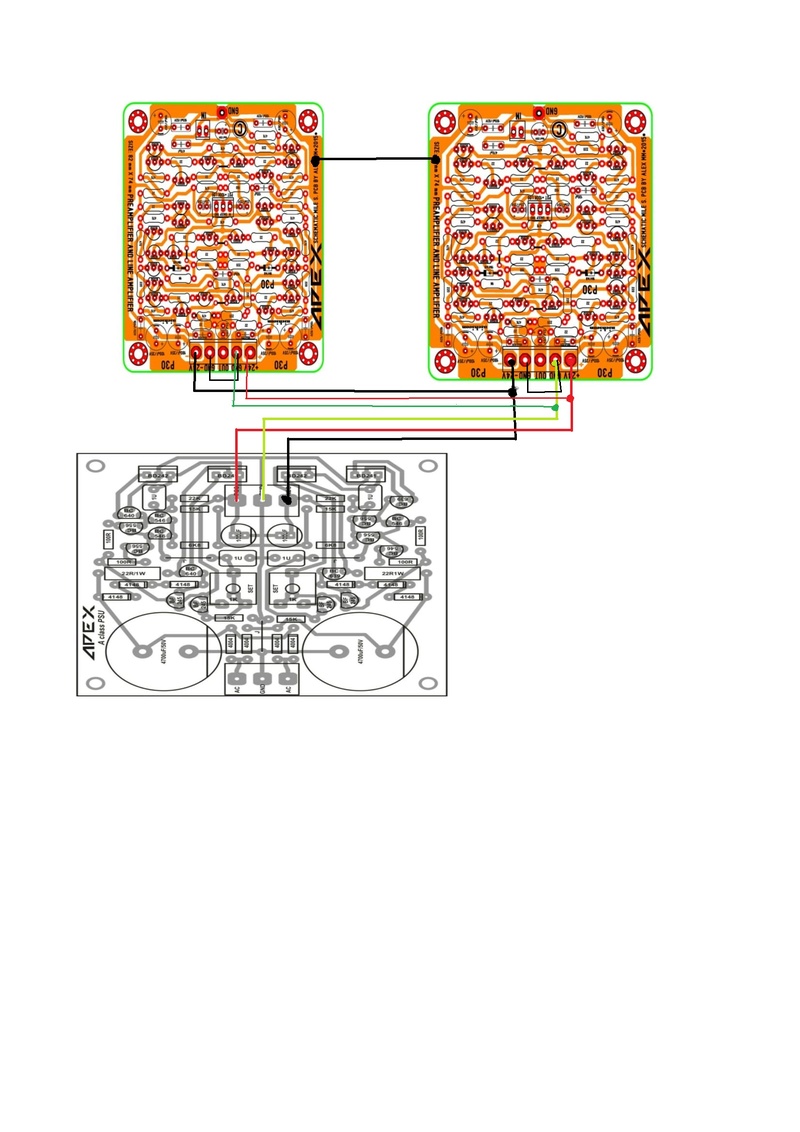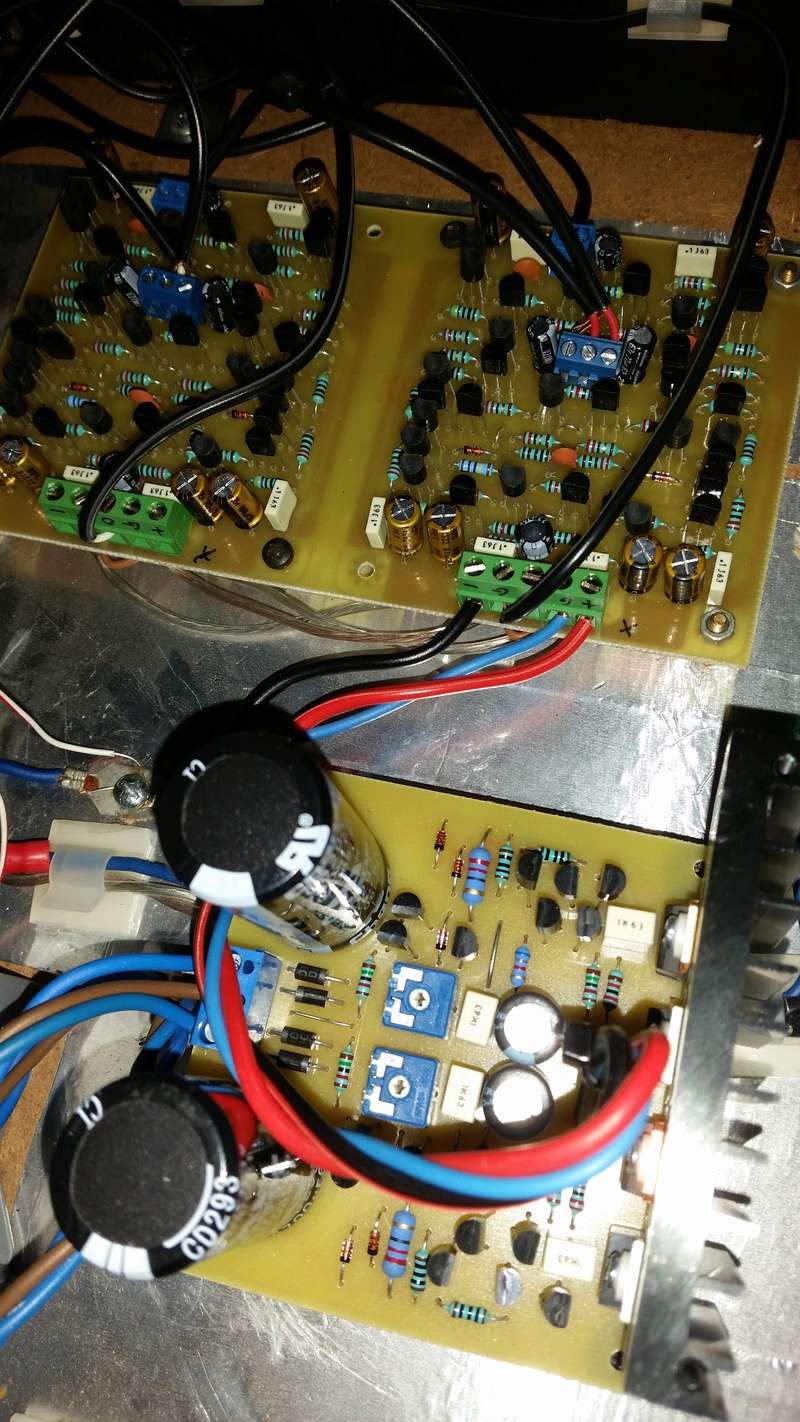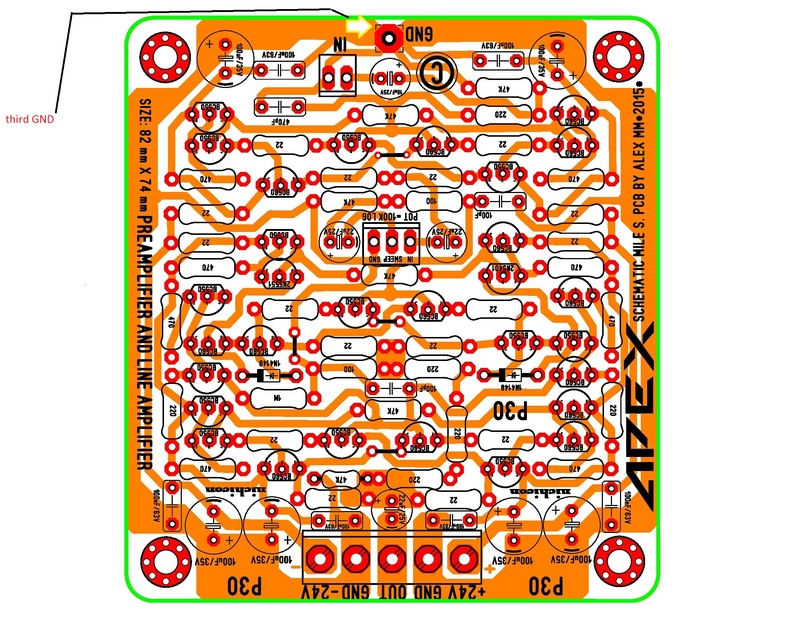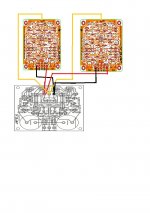Merry Christmas to you all,
as the title, I joined a preamp Apex P30 + A class PSU, see photo links .... I have a loud noise in the background, as if missing a GND connection ... I forget something?



as the title, I joined a preamp Apex P30 + A class PSU, see photo links .... I have a loud noise in the background, as if missing a GND connection ... I forget something?


... I forget something?
No, opposite, you have to many wires.
Remove wire between pcbs and two bridges on preamp pcbs.
No, opposite, you have to many wires.
Remove wire between pcbs and two bridges on preamp pcbs.
Ok provide. .....thanks




Your apex seems to have three GND terminals, but only two are connected. Maybe add the third connection and see.Ok provide. .....thanks
Your apex seems to have three GND terminals, but only two are connected. Maybe add the third connection and see.
saying in this picture ......

where to connect it?
saying in this picture ......

where to connect it?
Ok, l was not looking carefully. Ignore my previous comment.
How did you connect the PSU to the transformer and the mains?
the ground trace around the amp PCB is open at the power input end. It is not a loop.
You have added a connection that turns it into a loop.
That loop will pick up interference.
As long as you have no other connections to any points around that loop, then the interference currents do no harm.
But if you connect parts of the amplifier circuit to different points around the loop then all those tappings will be at DIFFERENT interference voltages.
I suspect you are hearing these interference voltages because the PCB layout designer did not have any clue about designing interference loop aerials into his layout.
You have to remove as many of the loops as possible.
You have to tap into the meandering ground trace at locations that minimise the interference voltages. This may be difficult and involve moving some tapping points around to new tapping points.
You may have to move all the signal tapping points off this power return trace and put them onto a signal return trace.
All these PCBs that have a long power return trace around the perimeter of the PCB have this same inherent fault. They generate interference voltages !
BTW,
Alex was informed of this some years ago, but so far I have only seen one PCB by Alex that avoids this power ground loop. All the others I have seen have this same problem.
You have added a connection that turns it into a loop.
That loop will pick up interference.
As long as you have no other connections to any points around that loop, then the interference currents do no harm.
But if you connect parts of the amplifier circuit to different points around the loop then all those tappings will be at DIFFERENT interference voltages.
I suspect you are hearing these interference voltages because the PCB layout designer did not have any clue about designing interference loop aerials into his layout.
You have to remove as many of the loops as possible.
You have to tap into the meandering ground trace at locations that minimise the interference voltages. This may be difficult and involve moving some tapping points around to new tapping points.
You may have to move all the signal tapping points off this power return trace and put them onto a signal return trace.
All these PCBs that have a long power return trace around the perimeter of the PCB have this same inherent fault. They generate interference voltages !
BTW,
Alex was informed of this some years ago, but so far I have only seen one PCB by Alex that avoids this power ground loop. All the others I have seen have this same problem.
Last edited:
Try running a separate power triplet from PSU to each amp PCB.
Won't cure the noise, but will improve the crosstalk.
Won't cure the noise, but will improve the crosstalk.
the ground trace around the amp PCB is open at the power input end. It is not a loop.
You have added a connection that turns it into a loop.
That loop will pick up interference.
As long as you have no other connections to any points around that loop, then the interference currents do no harm.
But if you connect parts of the amplifier circuit to different points around the loop then all those tappings will be at DIFFERENT interference voltages.
I suspect you are hearing these interference voltages because the PCB layout designer did not have any clue about designing interference loop aerials into his layout.
You have to remove as many of the loops as possible.
You have to tap into the meandering ground trace at locations that minimise the interference voltages. This may be difficult and involve moving some tapping points around to new tapping points.
You may have to move all the signal tapping points off this power return trace and put them onto a signal return trace.
All these PCBs that have a long power return trace around the perimeter of the PCB have this same inherent fault. They generate interference voltages !
BTW,
Alex was informed of this some years ago, but so far I have only seen one PCB by Alex that avoids this power ground loop. All the others I have seen have this same problem.
... I agree with your saying ... I have a noise in the background that does not disappear despite various links ...
Try running a separate power triplet from PSU to each amp PCB.
Won't cure the noise, but will improve the crosstalk.
Now I try it ... Thanks
Try running a separate power triplet from PSU to each amp PCB.
Won't cure the noise, but will improve the crosstalk.
done, but the slight background noise is present ...... It is a nice preamp, great sounding ... Unfortunately I have this problem ..😕😡
Let's try to identify the noise and maybe where it originates.
Is it pure hum @ mains frequency?
or
Hum plus Buzz due to lot's of harmonics of the mains frequency?
or
Noise like a hiss?
or
a mixture of the above?
Measure the H+N at the output of the Power Amplifier and post the result.
Is it pure hum @ mains frequency?
or
Hum plus Buzz due to lot's of harmonics of the mains frequency?
or
Noise like a hiss?
or
a mixture of the above?
Measure the H+N at the output of the Power Amplifier and post the result.
Let's try to identify the noise and maybe where it originates.
Is it pure hum @ mains frequency?
or
Hum plus Buzz due to lot's of harmonics of the mains frequency?
or
Noise like a hiss?
or
a mixture of the above?
Measure the H+N at the output of the Power Amplifier and post the result.
is a noise so> Is it well @ mains frequency hum?
... Unfortunately I can not measure h + n, I do not have the tool ... sorry🙁
- Status
- Not open for further replies.
- Home
- Source & Line
- Analog Line Level
- Apex P30+ A class PSU...questions?
